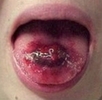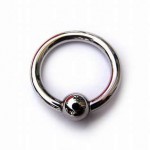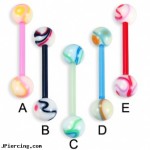If you have or want to get your tongue pierced, it is important to receive proper care to avoid infection and gum recession. Gum recession, or periodontitis, is a very common problem with tongue piercings due to the jewelry rubbing against the gums. This can eventually lead to exposed roots, which cause much pain and, eventually, loss of teeth.
When considering lip piercing, you should be aware of the risks that you may encounter while wearing lip ring. To avoid the most common risks of a lip ring piercing, book an appointment with a professional piercer to discuss your desire to get one. Ask about the healing process, and how you can avoid damage to your teeth and gums while wearing a lip ring.
Things You’ll Need
- Mouthwash
- Bioplast jewelry
-
Rinse your mouth with mouthwash on a daily basis to prevent infection. If you don’t have mouthwash available, rinse your mouth with peroxide. Some piercers also advise rinsing with a mild solution of sea salt, which kills bacteria.
- The placement of your lip or labret piercing could be discussed with your piercer to prevent your jewellery from resting on the gum area (as far backward on the tongue as possible), although this will inevitably limit the area which you can have pierced. If a piercer places your lip piercing in the incorrect location for your anatomy or you wear flat back jewelry that is too long for your piercing channel, recession of your gums can occur. The damage to your gum line occurs as the jewelry rubs or sits against your gum line when you make facial expressions, talk or chew.
- During the healing period, a lip ring that is too small to allow for swelling will irritate your piercing and lip. If the lip ring begins to sink into your piercing or cut your lip, the jewelry is too small. Skilled piercers use jewelry that can accommodate swelling. After your piercing heals, you will need to visit your piercer for a smaller ring that will not damage your teeth or gums.
-
Many people find that wearing a ring in the piercing (such as ball closure ring, body spiral, smooth segment ring or circular barbell) prevents gum recession as the curvature of the jewellery avoids the gum area. This will also depend on the piercing placement, but will almost always slow down and reduce effects of gum recession compared to labret studs that push against the gums with the backplate. It is possible for a piercing to rapidly stretch to for instance 3.3Â mm. During the initial period when the barbell is still long and/or thin, the pierced person should be especially careful while eating.
Products to consider include Ball Closure Rings, Body Spirals & Circular Barbells (the barbell should be as short as possible after initial healing). - Medilabsâ„¢ labret studs can be worn in the piercing, which may help reduce or even prevent gum recession altogether. Medilabsâ„¢ have a unique backplate filled with bio-compatible pure white ART-techâ„¢. The ART-techâ„¢ surface is lighter and softer than titanium or steel and causes less impact trauma when it touches teeth or gums by gently bouncing back and avoiding friction damage.
-
Use a segment ring (hoop jewelery that opens when you twist it) or exclusively bioplast tongue jewelry, such as barbells. Bioplast works best due to the consistency and flexibility of the plastic material. This type of jewelry does not interfere with the body’s cells and tissue, and therefore can prevent gum recession.
- Some people choose a type of pocketed piercing called a dermal anchor to reduce these risks. This piercing is more costly and difficult to place, but has no back to damage the teeth.
- Avoid smoking, as smoking coupled with a tongue piercing can give you an added risk of getting gum disease.
- Buy a new toothbrush to reduce the risk of introducing bacteria from the old one.
- Clean lip piercings with water or anti-microbial rinses after every meal.
- Do not chew gum, chew on objects, kiss or engage in oral sexual contact before the piercing has healed.
- Leave the jewelry in at all times to keep the piercing from healing over, and avoid touching the area.
Tips & Warnings
- Seek follow-up care after getting a tongue piercing, especially if your tongue swells, as swelling could lead to your piercing rubbing against your gums while eating.
- Make regular appointments to see your dentist. He will check to ensure that your gums are not at risk of recession and give you tips on proper oral care.
- If you experience the beginnings of gum recession, do not consume very cold or very hot foods, such as ice cream or coffee, because the exposed portion of your teeth will be especially sensitive and give you a lot of discomfort. See your dentist immediately.



ohh, that’s scary, this is important info for those who do tongue piercing